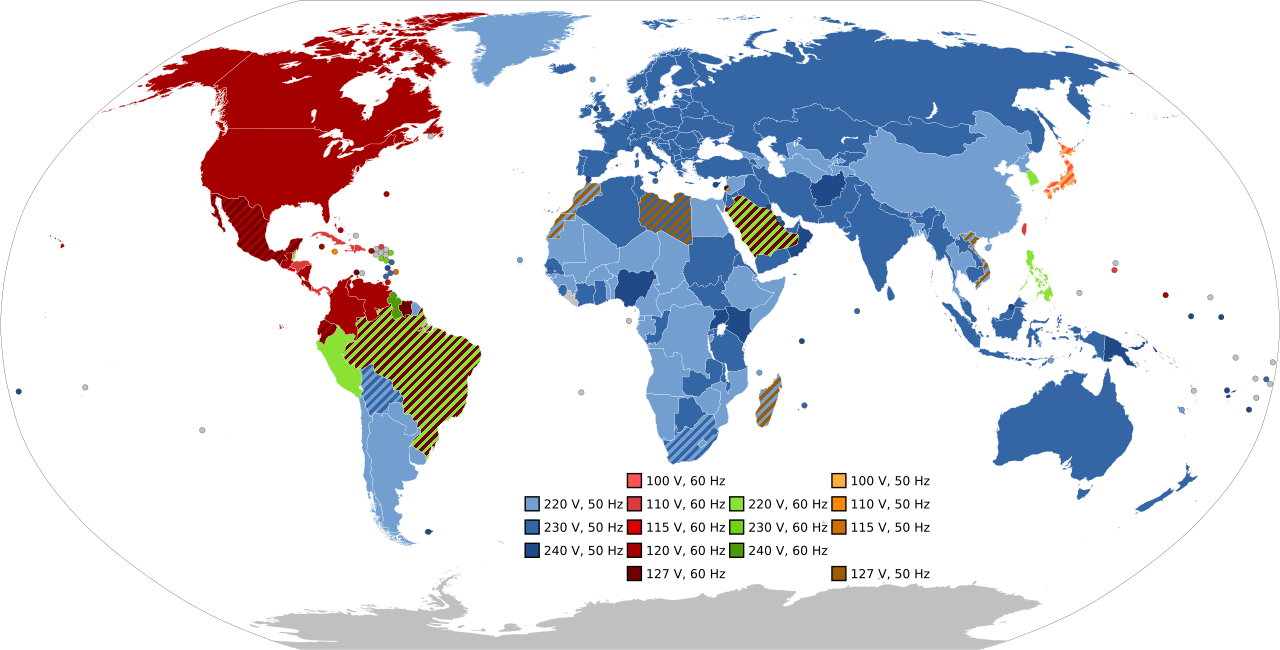Frequency and Voltage Supplied by Country Map


Marcus Rodriguez
Historical Geography Expert
Marcus Rodriguez specializes in historical cartography and geographic data analysis. With a background in both history and geography, he brings unique...
Geographic Analysis
What This Map Shows
The visualization titled "Most Common Frequency and Voltage Supplied in Each Country" provides a comprehensive overview of the electrical standards utilized across the globe. It highlights the frequency (measured in hertz) and voltage (measured in volts) specifications that different countries employ for their electrical systems. This topic is crucial for understanding the infrastructure that supports energy distribution and consumption worldwide. By mapping these variables, we can observe the diversity in electrical grids and the implications that arise from these differences.
Deep Dive into Electrical Standards
Electricity is a fundamental part of modern life, powering homes, industries, and technologies that drive our society. However, not all electrical systems are created equal. One of the most critical aspects of electrical supply is the frequency and voltage at which electricity is delivered. The most common frequencies worldwide are 50 Hz and 60 Hz, with 50 Hz being prevalent in Europe, Asia, Africa, and Australia, while 60 Hz is primarily used in the Americas.
Interestingly, the choice of frequency can influence the performance of electrical appliances and equipment. For example, devices designed for 60 Hz may not operate efficiently—or at all—when connected to a 50 Hz supply, and vice versa. This is because the internal mechanisms of many appliances, such as motors and transformers, are calibrated to operate at a specific frequency. Therefore, understanding these differences is crucial for international trade and travel.
Voltaic levels also vary significantly, with common standards being 120V, 220V, and 240V. For instance, North America predominantly uses 120V, which is suitable for lower power appliances, while many countries in Europe and Asia use 230V or higher, allowing for more efficient transmission of electricity over long distances. Lower voltages can lead to increased resistive losses during transmission, making higher voltage systems more appealing for extensive power grids.
In addition to consumer electronics, these voltage levels affect industrial machinery and infrastructure. Different industries may require specific voltage levels to optimize their operations. For example, high-voltage systems (e.g., 400V or more) are often employed in heavy industries, whereas lower voltages may be sufficient for residential use. As such, the map not only illustrates standard practices but also reflects the historical and economic context of each region.
Regional Analysis
When we look at the map, several regional patterns become evident. In Europe, countries like Germany, France, and the United Kingdom predominantly use 230V at 50 Hz. This standardization simplifies cross-border energy trading and the movement of electrical goods. However, unique cases exist, such as the United Kingdom’s distinctive plug design and voltage stability.
In contrast, North America’s 120V at 60 Hz system stands out as an anomaly. This discrepancy can be traced back to early electrical development practices, which solidified this standard in the region. Interestingly, Canada, while often aligned with U.S. standards, also accommodates certain areas that utilize 240V for specific applications, showcasing a blend of practices influenced by geography and history.
Asia presents a mixed bag. Countries like Japan use 100V, which is notably lower than global standards, and operate on two frequencies—50 Hz in the east and 60 Hz in the west. This duality leads to unique challenges in energy distribution and appliance compatibility. Other countries, like China and India, adopt 220V at 50 Hz, aligning them more closely with European standards.
In Africa, many nations are in the process of upgrading their electrical infrastructure. Countries like South Africa utilize 230V at 50 Hz, which facilitates regional integration with neighboring countries. However, many others still struggle with inconsistent supply and outdated systems, presenting both challenges and opportunities for development.
Significance and Impact
Understanding the frequency and voltage supplied in different countries has real-world implications that extend beyond mere technical specifications. For instance, this knowledge is vital for businesses looking to enter international markets. An appliance designed for a 230V system will not function in a 120V country without proper adaptation. Moreover, as the world becomes increasingly interconnected, the harmonization of electrical standards could facilitate global trade and technological advancement.
Additionally, the ongoing transition toward renewable energy sources necessitates a reevaluation of existing electrical standards. As countries strive to integrate solar, wind, and other renewable technologies into their grids, the existing infrastructure must adapt to accommodate these changes. This could involve modifying voltage levels or frequency standards to optimize the use of these new energy sources.
In conclusion, while seemingly technical, the topic of electrical frequency and voltage is deeply interconnected with global economic patterns, technological development, and even cultural practices. As we move further into the 21st century, understanding these systems will be essential for navigating the future of energy consumption and production around the globe.
Visualization Details
- Published
- October 9, 2025
- Views
- 50
Comments
Loading comments...